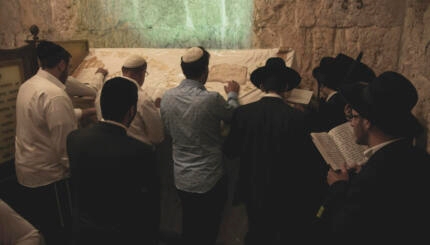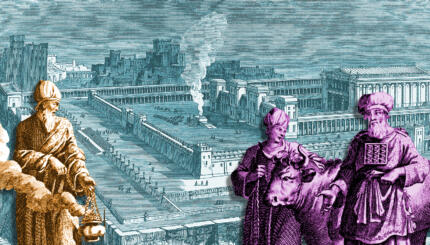It is commonly assumed that the average Jew on the street from biblical times onward followed rabbinic law. While rabbinic literature (and other ancient sources) report that “average Jews” were expected to observe rules concerning the Sabbath, dietary laws, and laws concerning sexual contact, it is not clear how widely general observance conformed to rabbinic rules. A careful study of rabbinic literature which distinguishes between tannaitic sources (through the second century CE) and amoraic sources (from the third through sixth centuries CE), and between Palestinian and Babylonian sources, reveals different pictures of how rabbis and non-rabbis interacted.
The Limits of Rabbinic Legal Authority
The Tannaim, the rabbis during the first two centuries of the Common Era, were acknowledged legal experts, but only in a small range of topics. An important study by scholar Shaye Cohen analyzed the range of legal cases described in tannaitic documents where rabbis responded to a case or made a ruling.
He found that the largest group of cases prior to Rabbi Judah the Patriarch (around the year 200 C.E.) dealt with purity laws and that two-thirds of the cases dealt with matters of purity, marital law, oaths, idolatry, and tithes. Only about one eighth of the cases dealt with civil law, the Sabbath and festivals, or kashrut. Rabbis were seen as experts in areas that were probably peripheral to the observance of most Jews; the common folk did not seek rabbinic authority for resolving questions that may have been of broader concern.
The Tannaim themselves were probably not concerned about this state of affairs. Tannaim expressed disdain for the common folk whom they called ammei ha’aretz, the people of the land. The Tosefta (Berakhot 6:18) refers to a rabbinic blessing praising God for having “not made me an outsider (bur),” explaining that an outsider, that is, one who does not adopt a rabbinic lifestyle, cannot really fear sin. The (Avot 3:14) expresses disdain in claiming that “sitting in the assemblies of ammei ha’aretz drives one out of the world.”

Help us keep Jewish knowledge accessible to millions of people around the world.
Your donation to My Jewish Learning fuels endless journeys of Jewish discovery. With your help, My Jewish Learning can continue to provide nonstop opportunities for learning, connection and growth.
The early rabbinic response to the ammei ha’aretz was separation, not education. In general, the Tannaim chose to teach their traditions orally, which necessarily limited the audience to those who would study with a master. Indeed, most of the learning occurred in small disciple circles. This was, at least partially, an effort to control the flow of information:
“The [subject of] forbidden sexual relations may not be explained in the presence of three, nor the work of creation [speculations about cosmology] in the presence of two, nor the chariot [mystical lore] in the presence of one, unless he is a sage and already understands out of his own knowledge” (Mishnah Hagigah 2:1).
As Cohen writes, “a limited number of masters teaching a limited number of disciples in a limited number of disciple circles was not the vehicle for mass education” (“The Place of the Rabbi in Jewish Society” in The Galilee in Late Antiquity, ed. Lee Levine).
Rabbi Judah the Patriarch
During the time of Rabbi Judah the Patriarch (around the beginning of the third century), rabbinic attitudes towards the common people began to change. Cohen notes that, unlike the earlier Tannaim, the cases that were brought before R. Judah had a much greater focus on general concerns and civil law, and less of a focus on matters of purity. Almost half of the cases deal with marital law, civil law, and kashrut; matters of purity reflect only one-eighth of the whole, and issues of tithes, priestly gifts, and idolatry are entirely absent.
Judah the Patriarch may have been instrumental in presenting rabbis to communities to serve as communal functionaries:
The people of Simonias came before Rabbi [Judah the Patriarch] and asked, ‘Give us one person who can preach, judge, teach, and perform all of our needs.’ He sent them Levi b. Sisi. (Yerushalmi Yebamot 12:7, 3a)
Prior to R. Judah, there are no examples of this kind of appointment of rabbis. Considering the unreasonably high expectations of the Simonians, perhaps having a rabbi as a communal functionary was new to them, also; alternatively, they were like any other community in any other period.
The earlier Tannaim were largely rural people of means who sympathized with landholders; the general view of Tannaitic documents is that the rabbis supported themselves. In the time of Judah the Patriarch, the ranks of the rabbis expanded and included the poor. The move of the Patriarch from the village of Bet Shearim to the city of Sepphoris also initiated a transfer of the rabbinic movement to urban centers. These processes– expanding the ranks of the rabbis and their gradual urbanization– may have had a significant impact on the nature of the interactions between the rabbis and the common folk.
The Amoraic Period in the Land of Israel
Evidence from ic literature indicates that the more urbanized rabbis of the third and fourth centuries in Palestine had a much broader array of interactions with the common folk. The range of legal cases adjudicated by rabbis continued to expand, and stories of regular encounters between rabbis and non-rabbis abound.
Some Palestinian rabbis even encouraged non-rabbis to marry their daughters to rabbis. Entrance into the rabbinic class was fairly open, and many sources refer to rabbis who are from non-rabbinic families or who are converts.
Although most rabbis continued to have independent sources of support, during the third and fourth century, there seems to have been a greater reliance on support from wealthy donors as well as from common folk who would separate a tithe for the sages. Rabbi Abba b. Kahana commented on the verse “You shall tithe your produce” (Deuteronomy 14:22):
“This refers to the merchants and seafarers who give a tithe to those who work at (studying) the Torah” (Pesikta deRav Kahana 10:10).
Clearly the rabbis believed that the people should help support their work. Since such stories of non-rabbis–especially wealthy non-rabbis–providing support for rabbis are widespread in rabbinic sources from the land of Israel, it is unlikely that these interactions are merely rabbinic fantasies.
The Amoraic Period in Babylonia
According to Richard Kalmin (The Sage in Jewish Society in Late Antiquity), the rabbis of Babylonia maintained a much greater degree of separation from the non-rabbinic community than did the rabbis of the land of Israel. Babylonian rabbis were more concerned about issues of lineage; in practice, it may have been much more difficult to enter the rabbinic class in Babylonia than it was in the land of Israel.
Babylonian rabbinic interaction with non-rabbis is often described in formal contexts that show disinterest, disregard, and disdain. Significantly, the Tannaitic statements of disdain for ammei ha’aretz described above appear reworked in the Babylonian Talmud as statements of hatred:
“Rabbi Elazar said, ‘It is permitted to stab an am ha’aretz on which falls on Shabbat.’… It was taught, R. Akiba said, ‘When I was an am ha’aretz, I said, “I wish someone would give me a disciple of the sages. I’d bite him like an ass!”‘”(Pesachim 49b).
While sources like this–which reflect open hatred by the sage for the am ha’aretz and vice versa–refer to Palestinian rabbis, they appear only in the Babylonian Talmud and probably reflect the worldview of the Babylonian sage.
This distinction, that Palestinian rabbis sought greater influence with non-rabbis in order to secure their position while Babylonian rabbis preserved significant, hierarchical barriers, Kalmin argues, reflect the differences in structure between Roman and Persian culture in which the communities functioned.
Nevertheless, during the fourth generation of Babylonian Amoraim (in the fourth century), one begins to find statements of greater openness towards non-rabbinic Jews. Sources from this generation encourage non-rabbinic support for rabbis. This tendency towards greater interaction in the later strata of the Babylonian Talmud continues the trend which began earlier in the land of Israel.


